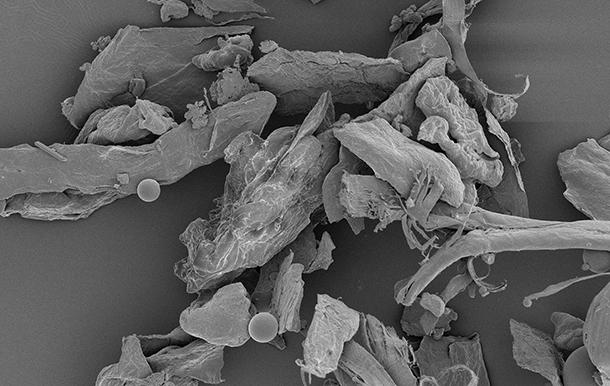Could house dust contribute to weight gain and obesity?
House dust under high magnification.
New research from Duke University finds that typical amounts of household dust spurred the growth of mouse fat cells in a lab dish.
While this news may have you running for the vacuum, Chris Kassotis, a postdoctoral fellow at Duke’s Nicholas School for the Environment who conducted the research, cautions against overreacting.
“We definitely are not saying that house dust will make people fat,” says Kassotis. “This is a preliminary step on that pathway. First, we're showing that house dust can stimulate the development of fat cells in the lab … [I]t’s a little too early to say that it would act the same way in an animal or, ultimately, in a human.”
In the human body, certain hormones instruct our systems whether or not to create fat cells. Many common products — such as plastics, flame retardants and pesticides — contain chemicals known to affect these hormones. Ironically, one of these chemicals, triclosan, is also found in some household cleaning products.
In the study, Kassotis used “fat precursor cells” from mice. “If we think about the development of any differentiated or final cell type, like a bone cell or a fat cell in the body, those are fully developed cells,” he explains. “[Our] cell model is made up of cells that are ‘committed’ to become fat cells at some point in time. They can't develop into any other cell type at this point, but without some sort of further push they're going to sit in their early state and not take on the characteristics of what we think of as a mature fat cell.”
“However, if they get that push, which we can give them by exposing them to some of these environmental contaminants over the course of two weeks in the lab, they then undergo a series of changes,” he continues. “They become more spherical in shape and they start to accumulate lipid into the cell.”
Kassotis and his colleagues measured the lipid content and the number of affected cells. They found that various contaminants can increase both the lipid content, which, he says, is “a rough proxy for fat cell size,” and the number of cells, which can “create a larger pool for recruiting mature fat cells.”
Kassotis says he was surprised that these effects were measurable at very low levels of exposure.
“The Environmental Protection Agency estimates that a child consumes about 50 mg of dust per day, which is a very small amount. The level of dust that spurred fat cell development in our study was 10,000 times lower than that,” he explains. “So while there isn't a direct translation from a concentration that we use in this model to a dose that a child eats, the magnitude of that difference is concerning to us.”
Gaps remain in scientists’ understanding of this topic, Kassotis cautions, including what level of exposure to a certain chemical can result in a health effect. He normally tells people, if they are concerned, that there are plenty of steps they can take to reduce exposure to these chemicals.
“One of the things that we often tell people is that dusting frequently is a good way to reduce exposure,” Kassotis says. “With that said, we suspect that dry dusting may actually just kick these chemicals back up in the air and make it easier to inhale them. So it really should be a wet dusting, to avoid increasing your exposure to these chemicals.”
For the researchers, the next step is to see if mice or rats exposed to house dust through their diet show some sort of metabolic risk or disruption, whether that's weight gain or some other outcome that they can measure. The second step is to look for an association in humans.
“That's going to take a larger study, with a lot more house dust,” Kassotis says. “[Since] we commonly talk about children being the most sensitive to exposures of this type, it may be we really have to look at young adults or children and their metabolic health to find any sort of connection.”
This article is based on an interview that aired on PRI’s Living on Earth with Steve Curwood.
Our coverage reaches millions each week, but only a small fraction of listeners contribute to sustain our program. We still need 224 more people to donate $100 or $10/monthly to unlock our $67,000 match. Will you help us get there today?
